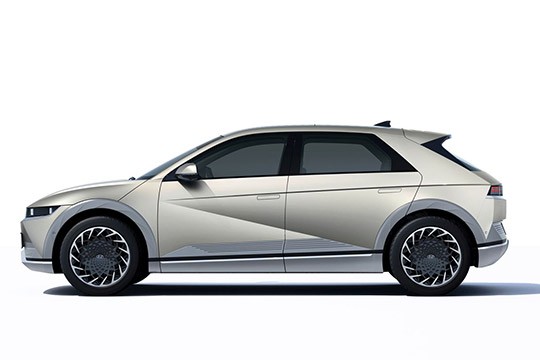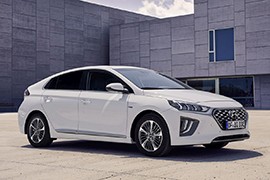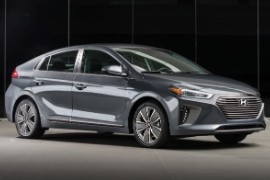HYUNDAI Ioniq Models/Series Timeline, Specifications & Photos
First production year: 2016
Engines: Electric, Hybrid, Hybrid gasoline
Body style: Hatchback
The Korean carmaker introduced the second generation of its electric Ioniq 5 model at the beginning of 2021 with a CUV-like appearance and a stunning design.
Ioniq 5 was based on the Hyundai 45 EV design study and resembled the 45 years brand's history. It was built on the E-GMP platform that brought a longer wheelbase and featured a more muscular appearance. The sci-fi design and angular-sculptured side panels paved the way for a Korean carmaker's new design language.
Hyundai's first car on the market was the 1975 Pony designed by Giorgetto Giugiaro, and the 2021 Ioniq 5 took its inspiration from that model. At the front, the clam-shell design continued to minimize the grille and pushed the company's logo on the hood. From its sides, the huge wheelbase for its car category led to a spacious interior.
Inside, Hyundai took the minimalist design to a different level. The dashboard was divided into an upper and lower section, with just a few buttons on the center stack. There was a 12" TFT display for the instrument panel in front of the driver and, in the middle of the dash panel, an additional 12" screen for the infotainment system. Both of them were mounted on a shared board. The front passenger's seat featured a foot-rest to enjoy more comfort on longer journeys. There was room for three passengers in the rear, and, thanks to the completely flat floor and the 3.0-meters (118") wheelbase, they all had enough legroom.
The carmaker offered the 2021 Ioniq 5 with two power options. Customers could choose between a rear-engine, rear-wheel-drive solution or two motors (one on each axle). Also, the carmaker offered two battery options. Another important innovation was the electric system, which allowed high-voltage and high-power charging stations of up to 800 volts.
Hyundai developed the Ioniq with a platform fit to accommodate hybrid and electric drivetrains so it could please more customers and provide them with a vehicle that could help them transition from ICE cars to EVs.
In 2016, Hyundai introduced the Ioniq nameplate in its inventory, and the car was available as a hybrid, a plug-in hybrid, and an all-electric model. Three years later, in 2019, the automaker unveiled the improved version of this hatchback, trying to keep the car’s sales high. Despite the global pandemic that started in 2020, the Korean automaker managed to deliver over 300,000 units before January 2021. Furthermore, the refreshed version offered customers not just an update on the car’s look but also on the drivetrain upgrades.
In 2019, Hyundai refreshed the Ioniq, and the entire lineup received a revised front fascia that featured new headlights, which were available with LED bulbs. In addition, the broad grille was redesigned, and the electric version sported a silver panel where the badge took center stage. Lower on the bumper, the automaker integrated a lower air intake, and on the side scoops, it installed blade-like LED daytime running lights.
The car’s profile kept its original hatchback shape with a sloped-down roof line that continued with the raked forward tailgate. Unlike other automakers, who chose flush door handles, Hyundai installed grab-styled ones, lowering overall production costs. Along with the facelift, the Ioniq also received new alloy wheels ranging between 15- and 17-inch in size. Finally, at the back, the automaker added LED taillights, and the rear apron featured black moldings.
Inside the 2020 Ioniq, customers found a new dashboard fitted with a larger 10.25-inch touchscreen placed atop the center stack in a free-floating position that featured Apple CarPlay and Android Auto. Inside the instrument cluster, the automaker added a seven-inch display fitted as standard in the electric version and as an option depending on the trim level for the rest of the range. An Infinity sound system was also offered to enhance the audio experience in the vehicle. At the back, the split-folding bench seat could accommodate up to three people for short trips or two for long journeys. Still, legroom and headroom were nothing to write home about. Along with the facelifted version, Hyundai also improved the safety systems, and all Ioniq versions came fitted with collision warning and pedestrian detection. In addition, a radar-based adaptive cruise control was on the table as well.
For the drivetrain, the most significant upgrade was for the electric version, which was fitted with a 38.3 kWh battery pack instead of the formerly used 28 kWh one. This upgrade led to an increased range of up to 186 miles (300 km.). Starting with the 2020 model year, the Ioniq also received a new base model powered by a 105 PS (104 hp) internal combustion engine.
The 2016 Hyundai Ioniq was designed from the start to be delivered in three versions: hybrid, plug-in hybrid and full-electric. By doing this, the car could have been equipped with batteries without altering the rest of the vehicle.
It was not a secret for anyone that Hyundai targeted the Toyota Prius when it launched the Ioniq. It took everything that people liked about Toyota and improved it in every way. It was the same recipe that Toyota used when it started to sell cars in the U.S. or Europe.
The wedged shape of the car, with a sloped rear and a long liftgate. The sloped rear end was similar to the Prius idea of a long tailgate that covered a large and accessible trunk. Under the trunk's floor, the Ioniq featured a space-saver spare wheel instead of a flat-tire repair kit.
On the inside, Hyundai managed to install an impressive list of features as standard, such as the leather steering wheel, autonomous emergency braking, and lane-keep assist. For the upper trim levels, there was available a heated steering wheel, heated and ventilated seats. The 7” infotainment unit included the navigation system and was compatible with Android Auto and Apple Car Play.
There were three powertrain options. There was a standard hybrid, a plug-in hybrid, and a fully electric version. The latter was not available for the Toyota Prius.


